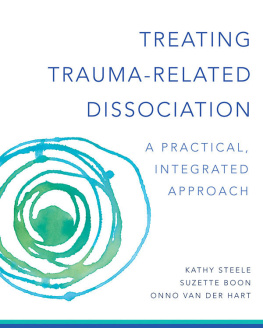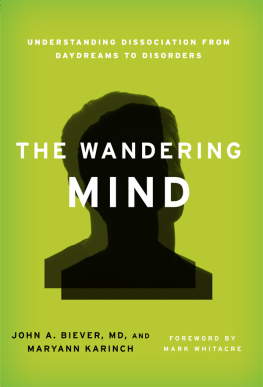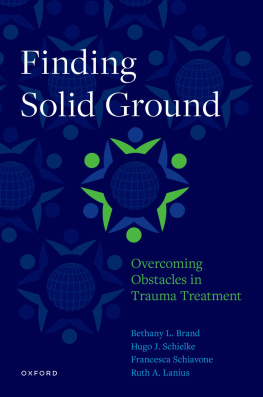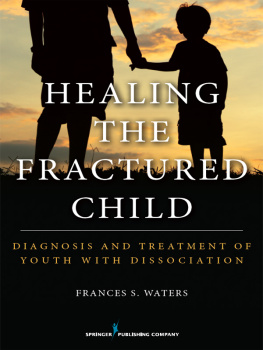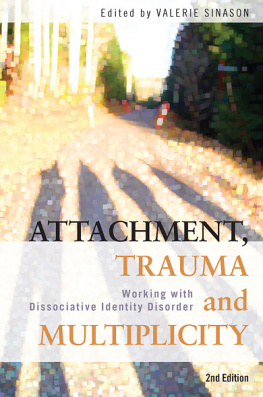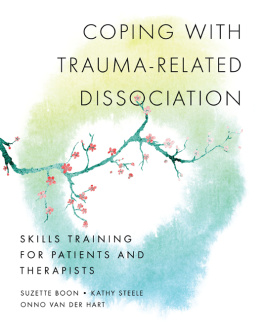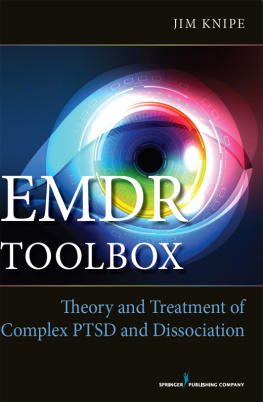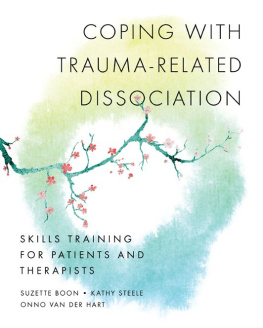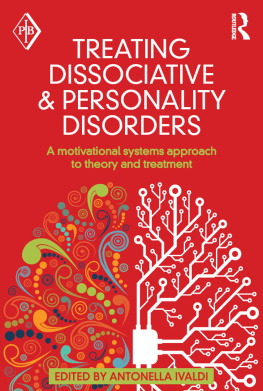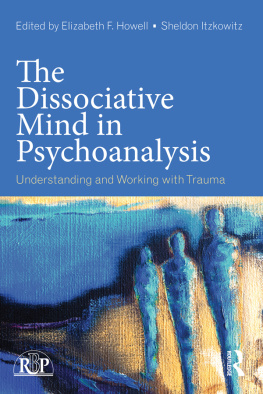A NORTON PROFESSIONAL BOOK
Treating
Trauma-Related Dissociation
A Practical, Integrative Approach
KATHY STEELE
SUZETTE BOON
ONNO VAN DER HART

W. W. NORTON & COMPANY
Independent Publishers Since 1923
New York London
To all patients and therapists around the world who choose this challenging journey, who are willing to risk and persevere together in an imperfect but wholly good enough psychotherapy. To each of you, an abundance of compassion, courage, and clarity.
CONTENTS
PART I
The Therapeutic Relationship
PART II
Assessment, Case Formulation, and Treatment Planning
PART III
Phase 1 Treatment and Beyond
PART IV
Phase 2 Treatment
PART V
Phase 3 Treatment
T his book was born not only out of countless hours of treating patients with dissociative disorders, but also out of the crucible of supervision and consultation, where therapists bring their most urgent questions, needs, and vulnerabilities. For many years we have heard therapists around the world ask similar questions and struggle with similar challenges with dissociative patients. In addition to an overview of phase-oriented treatment, it is this set of issues we have tried to bring to this volume: what to focus on first in a complex therapy, and how to do it; how to establish safety for a patient engaging in unsafe behaviors without rescuing; how to work with dissociative parts in ways that facilitate integration rather than further dissociation; how to set and maintain helpful boundaries; how to deal compassionately and effectively with dependency on the therapist; how to help patients integrate traumatic memories; what to do when the patient is enraged, chronically ashamed, avoidant, or unable to experience the therapist as having any good intentions; and how to compassionately understand and work with resistances. Most importantly, we have focused not only on how to conceptualize and treat dissociation but on how to be with patients who experience themselves as many instead of one.
Doing Versus Being
Most therapists who are just becoming familiar with working with dissociative patients are seeking techniques. When one is faced with complexity and unfamiliar territory, it is the most natural thing in the world to seek out what to do . These therapists will find that treatment of patients with dissociative disorders includes some very practical techniques that support gradual integration. Nevertheless, relational ways of being with the patient are the backbone of treatment, and are themselves essentialtherapeutic interventions.
The task of every good therapist is to seamlessly interweave a coherent combination of cognitive, emotional, and somatic interventions (things to do) with the relational experience in the moment between two human beings in a two-person psychology (ways to be). In fact, there is nothing more practical and integrative than making the therapeutic relationship an integral part of working with patients who have been so wounded by others. The findings of interpersonal neurobiology point more and more to the centrality and transforming power of implicit relational interactions in therapy (e.g., Cozolino, 2010; Schore, 2012; Siegel, 2010b, 2015). The effect size of the impact of the therapeutic relationship is even greater in patients with dissociative disorders than in many other clinical populations (Cronin, Brand, & Mattanah, 2014), so relational processes with these patients deserve extra attention and care. Yet, despite recommendations by experts to the contrary, therapists generally underutilize the relationship as a therapeutic process (Brand et al., 2013). Thus, we have set out to embed in a relational context a practical and integrative approach with as many and as varied techniques as possible for what often is a challenging and complex therapy.
When faced with urgency, crisis, and confusion, it is especially hard to follow the wise adage Dont just do something; stand there . Words may fail or are misinterpreted in therapy; interventions fall flat or are rejected out of hand; good intentions fall short; and issues emerge that are beyond any directive action to change or fix. Interventions then become invisible, transmuting into nonverbal, implicit, unconscious, intersubjective ways of being. Thus, we offer a slight twist on that old truism: Dont just do something; be there . Such relational interchanges are the hardest for therapists to recognize and participate in effectively. But they are so very important. We have tried to include ways for the therapist to communicate what is not communicable with words. This is essential for highly traumatized patients who are often living in an overwhelming inner world in which words have lost their meaning and language is not possible. To this end, we have also tried to include somatic interventions that are helpful when words fail or are not sufficient.
The common factors theory of psychotherapy suggests that particular theoretical approaches play little overall role in whether patients improve or not. Common factors that do make a significant contribution to the patients improvement include collaboration on shared goals, therapeutic alliance, empathy of the therapist, positive regard and affirmation, congruence and genuineness of the therapist, and other therapist factors (Laska, Gurman, & Wampold, 2014; Wampold, 2001). These findings do not imply that therapists should abandon theory and technique in the treatment of patients with dissociative disordersor any other disorder, for that matter. We believe an organized and thoughtful approach to treatmentregardless of what it isis necessary for common factors to be effective. Even with sound relational approaches that include a solid treatment frame and boundaries, therapists still need special techniques to work with dissociative parts, at least in patients who have severe dissociative disorders. Such techniques are central to the effective treatment of these patients (e.g., Boon, Steele, & Van der Hart, 2011; Brand et al., 2011; Kluft, 1991, 1993a, 1995; Van der Hart, Nijenhuis, & Steele, 2006).
The Humbling Experience of Treating Patients With Dissociative Disorders
We offer the contents of this book with a large dose of humility, realizing that no single clinician has all the right or best answers. Even though the three of us have over 120 years of experience in treating patients with dissociative disorders between us, we are nevertheless acutely aware of so much that we do not know, that we cannot know, that others know so much more clearly than we do; and of the mistakes we so often make. However, we offer you what we do know, and what we are reasonably certain will add to your skills in treating patients with dissociative disorders.
We also acknowledge that evidence-based treatment of patients with dissociative disorders is still in its infancy, so the approaches in this book are based primarily on clinical wisdom and experience (a legitimate form of evidence), not randomized controlled research. Fortunately, there is a healthy and burgeoning body of empirical literature on the effectiveness of these time-honored, anecdotal approaches to working with dissociative patients (Brand, Classen, Lanius, et al., 2009; Brand & Loewenstein, 2014; Brand, Loewenstein, & Spiegel, 2014; Myrick, Chasson, Lanius, Leventhal, & Brand, 2015). What weand othershave found successful in clinical practice is finally being validated by research. But we caution readers to stay abreast of current research and treatment recommendations.
In some ways we may seem to be trying to impose linear order on what is a very complex and messy process in the therapy room. We are perhaps guilty of making it seem easier than it is. However, we truly know from our own experiences that there is perhaps no other therapy that challenges the therapists sense of competence so profoundly as work with chronically traumatized individuals. The humbling reality for all of us is that therapy can be uneven and uncertain, challenging and confusing. We, like other therapists, find ourselves sometimes lost for a moment, not knowing what to do or how to be, making unintentional mistakes, missing important cues, caught by transference and countertransference. Some of the lessons we share in this book evolved not only from our successes but also from our failures and mistakes. We hope you, the reader, will benefit from our mishaps as much as from our triumphs. We also hope that you can embrace your own mistakes and learn from them, knowing that you are not required to be perfect for this work, and every therapist would do best to eventually shed the heavy and unrealistic burden of perfection.
Next page
